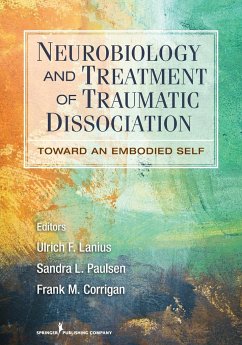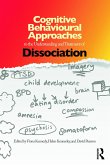Ulrich F. Lanius, Sandra L. Paulsen, Frank M. Corrigan
Neurobiology and Treatment of Traumatic Dissociation
Towards an Embodied Self
Ulrich F. Lanius, Sandra L. Paulsen, Frank M. Corrigan
Neurobiology and Treatment of Traumatic Dissociation
Towards an Embodied Self
- Broschiertes Buch
- Merkliste
- Auf die Merkliste
- Bewerten Bewerten
- Teilen
- Produkt teilen
- Produkterinnerung
- Produkterinnerung
Encompassing the contributions of expert clinicians and researchers in the area of traumatic stress and dissociation, this volume is the first to integrate current neuroscience research regarding traumatic dissociation with several cutting-edge approaches to treatment, providing a comprehensive, neurobiologically based treatment approach.
Andere Kunden interessierten sich auch für
![Cognitive Behavioural Approaches to the Understanding and Treatment of Dissociation Cognitive Behavioural Approaches to the Understanding and Treatment of Dissociation]() Cognitive Behavioural Approaches to the Understanding and Treatment of Dissociation48,99 €
Cognitive Behavioural Approaches to the Understanding and Treatment of Dissociation48,99 €![Relational and Body-Centered Practices for Healing Trauma Relational and Body-Centered Practices for Healing Trauma]() Sharon StanleyRelational and Body-Centered Practices for Healing Trauma56,99 €
Sharon StanleyRelational and Body-Centered Practices for Healing Trauma56,99 €![Healing the Fragmented Selves of Trauma Survivors Healing the Fragmented Selves of Trauma Survivors]() Janina FisherHealing the Fragmented Selves of Trauma Survivors37,99 €
Janina FisherHealing the Fragmented Selves of Trauma Survivors37,99 €![Healing the Fragmented Selves of Trauma Survivors Healing the Fragmented Selves of Trauma Survivors]() Janina FisherHealing the Fragmented Selves of Trauma Survivors138,99 €
Janina FisherHealing the Fragmented Selves of Trauma Survivors138,99 €![Trauma and Its Impacts on Temporal Experience Trauma and Its Impacts on Temporal Experience]() Selene MezzaliraTrauma and Its Impacts on Temporal Experience41,99 €
Selene MezzaliraTrauma and Its Impacts on Temporal Experience41,99 €![Retraumatization Retraumatization]() Retraumatization45,99 €
Retraumatization45,99 €![Working with Video Gamers and Games in Therapy Working with Video Gamers and Games in Therapy]() Anthony M. BeanWorking with Video Gamers and Games in Therapy41,99 €
Anthony M. BeanWorking with Video Gamers and Games in Therapy41,99 €-
-
-
Encompassing the contributions of expert clinicians and researchers in the area of traumatic stress and dissociation, this volume is the first to integrate current neuroscience research regarding traumatic dissociation with several cutting-edge approaches to treatment, providing a comprehensive, neurobiologically based treatment approach.
Hinweis: Dieser Artikel kann nur an eine deutsche Lieferadresse ausgeliefert werden.
Hinweis: Dieser Artikel kann nur an eine deutsche Lieferadresse ausgeliefert werden.
Produktdetails
- Produktdetails
- Verlag: Springer Publishing Co Inc
- Seitenzahl: 538
- Erscheinungstermin: 13. Mai 2014
- Englisch
- Abmessung: 254mm x 178mm x 29mm
- Gewicht: 1004g
- ISBN-13: 9780826106315
- ISBN-10: 0826106315
- Artikelnr.: 34011579
- Herstellerkennzeichnung
- Libri GmbH
- Europaallee 1
- 36244 Bad Hersfeld
- gpsr@libri.de
- Verlag: Springer Publishing Co Inc
- Seitenzahl: 538
- Erscheinungstermin: 13. Mai 2014
- Englisch
- Abmessung: 254mm x 178mm x 29mm
- Gewicht: 1004g
- ISBN-13: 9780826106315
- ISBN-10: 0826106315
- Artikelnr.: 34011579
- Herstellerkennzeichnung
- Libri GmbH
- Europaallee 1
- 36244 Bad Hersfeld
- gpsr@libri.de
Ulrich F. Lanius, PhD, RPsych, BCETS, is a clinical and neuropsychological psychologist, EMDRIA Approved Consultant, and EMDR Institute Facilitator who is currently in private practice in British Columbia, Canada.
Contributors ix
Foreword by Jaak Panskepp, PhD xi
Preface xv
Introduction: The Ubiquity of Dissociation by Sandra L. Paulsen and Ulrich
F. Lanius xix
PART I. NEUROBIOLOGY
Introduction: Dissociation and Neurobiology 1
Ulrich F. Lanius
1. Dissociation: Cortical Deafferentation and the Loss of Self 5
Ulrich F. Lanius, Sandra L. Paulsen, and Frank M. Corrigan
2. Threat and Safety: The Neurobiology of Active and Passive Defense
Responses 29
Frank M. Corrigan
3. Peritraumatic Dissociation and Tonic Immobility: Clinical Findings 51
Michelle J. Bovin, Elise Ratchford, and Brian P. Marx
4. A Social-Cognitive-Neuroscience Approach to PTSD: Clinical and Research
Perspectives 69
Ruth Lanius, Paul Frewen, Anthony Nazarov, and Margaret C. McKinnon
5. Dissociation and Endogenous Opioids: A Foundational Role 81
Ulrich F. Lanius
6. Attachment, Neuropeptides, and Autonomic Regulation:
A Vagal Shift Hypothesis 105
Ulrich F. Lanius
7. Defense Responses: Frozen, Suppressed, Truncated, Obstructed, and
Malfunctioning 131
Frank M. Corrigan
8. The Clinical Sequelae of Dysfunctional Defense Responses: Dissociative
Amnesia,
Pain and Somatization, Emotional Motor Memory, and Interoceptive Loops 153
Frank M. Corrigan
9. Shame and the Vestigial Midbrain Urge to Withdraw 173
Frank M. Corrigan
10. Attachment and Attachment Repair 193
Frank M. Corrigan, Alistair Wilson, and Deirdre Fay
11. Dissociation, EMDR, and Adaptive Information Processing: The Role of
Sensory
Stimulation and Sensory Awareness 213
Ulrich F. Lanius and Uri Bergmann
PART II. TREATMENT
Introduction: Dissociation and Psychotherapy 243
Sandra L. Paulsen and Ulrich F. Lanius
12. Seeing That Which Is Hidden: Identifying and Working
With Dissociative Symptoms 247
Sandra L. Paulsen and Ulrich F. Lanius
13. The Compassionate Self 269
Frank M. Corrigan, Alistair Wilson, and Deirdre Fay
14. Stabilization Basics 289
Sandra L. Paulsen and Joan Golston
15. Stabilizing the Relationship Among Self-States 321
Sandra L. Paulsen and Joan Golston
16. Alexithymia, Affective Dysregulation, and the Imaginal: Resetting the
Subcortical
Affective Circuits 341
Sandra L. Paulsen, Katie O'Shea, and Ulrich F. Lanius
17. Fractionating Trauma Processing: TOTEMSPOTS and Other
Attenuating Tactics 367
Sandra L. Paulsen and Ulrich F. Lanius
vi Contents
18. Accelerating and Decelerating Access to Self-States 383
Sandra L. Paulsen
19. Integrating Body and Mind: Sensorimotor Psychotherapy and Treatment of
Dissociation, Defense, and Dysregulation 399
Pat Ogden and Janina Fisher
20. Temporal Integration of Early Trauma and Neglect 423
Sandra L. Paulsen
21. Toward an Embodied Self: EMDR and Somatic Interventions 447
Ulrich F. Lanius and Sandra L. Paulsen
22. Opioid Antagonists and Dissociation: Adjunctive
Pharmacological Interventions 471
Ulrich F. Lanius and Frank M. Corrigan
Index 499
Foreword by Jaak Panskepp, PhD xi
Preface xv
Introduction: The Ubiquity of Dissociation by Sandra L. Paulsen and Ulrich
F. Lanius xix
PART I. NEUROBIOLOGY
Introduction: Dissociation and Neurobiology 1
Ulrich F. Lanius
1. Dissociation: Cortical Deafferentation and the Loss of Self 5
Ulrich F. Lanius, Sandra L. Paulsen, and Frank M. Corrigan
2. Threat and Safety: The Neurobiology of Active and Passive Defense
Responses 29
Frank M. Corrigan
3. Peritraumatic Dissociation and Tonic Immobility: Clinical Findings 51
Michelle J. Bovin, Elise Ratchford, and Brian P. Marx
4. A Social-Cognitive-Neuroscience Approach to PTSD: Clinical and Research
Perspectives 69
Ruth Lanius, Paul Frewen, Anthony Nazarov, and Margaret C. McKinnon
5. Dissociation and Endogenous Opioids: A Foundational Role 81
Ulrich F. Lanius
6. Attachment, Neuropeptides, and Autonomic Regulation:
A Vagal Shift Hypothesis 105
Ulrich F. Lanius
7. Defense Responses: Frozen, Suppressed, Truncated, Obstructed, and
Malfunctioning 131
Frank M. Corrigan
8. The Clinical Sequelae of Dysfunctional Defense Responses: Dissociative
Amnesia,
Pain and Somatization, Emotional Motor Memory, and Interoceptive Loops 153
Frank M. Corrigan
9. Shame and the Vestigial Midbrain Urge to Withdraw 173
Frank M. Corrigan
10. Attachment and Attachment Repair 193
Frank M. Corrigan, Alistair Wilson, and Deirdre Fay
11. Dissociation, EMDR, and Adaptive Information Processing: The Role of
Sensory
Stimulation and Sensory Awareness 213
Ulrich F. Lanius and Uri Bergmann
PART II. TREATMENT
Introduction: Dissociation and Psychotherapy 243
Sandra L. Paulsen and Ulrich F. Lanius
12. Seeing That Which Is Hidden: Identifying and Working
With Dissociative Symptoms 247
Sandra L. Paulsen and Ulrich F. Lanius
13. The Compassionate Self 269
Frank M. Corrigan, Alistair Wilson, and Deirdre Fay
14. Stabilization Basics 289
Sandra L. Paulsen and Joan Golston
15. Stabilizing the Relationship Among Self-States 321
Sandra L. Paulsen and Joan Golston
16. Alexithymia, Affective Dysregulation, and the Imaginal: Resetting the
Subcortical
Affective Circuits 341
Sandra L. Paulsen, Katie O'Shea, and Ulrich F. Lanius
17. Fractionating Trauma Processing: TOTEMSPOTS and Other
Attenuating Tactics 367
Sandra L. Paulsen and Ulrich F. Lanius
vi Contents
18. Accelerating and Decelerating Access to Self-States 383
Sandra L. Paulsen
19. Integrating Body and Mind: Sensorimotor Psychotherapy and Treatment of
Dissociation, Defense, and Dysregulation 399
Pat Ogden and Janina Fisher
20. Temporal Integration of Early Trauma and Neglect 423
Sandra L. Paulsen
21. Toward an Embodied Self: EMDR and Somatic Interventions 447
Ulrich F. Lanius and Sandra L. Paulsen
22. Opioid Antagonists and Dissociation: Adjunctive
Pharmacological Interventions 471
Ulrich F. Lanius and Frank M. Corrigan
Index 499
Contributors ix
Foreword by Jaak Panskepp, PhD xi
Preface xv
Introduction: The Ubiquity of Dissociation by Sandra L. Paulsen and Ulrich
F. Lanius xix
PART I. NEUROBIOLOGY
Introduction: Dissociation and Neurobiology 1
Ulrich F. Lanius
1. Dissociation: Cortical Deafferentation and the Loss of Self 5
Ulrich F. Lanius, Sandra L. Paulsen, and Frank M. Corrigan
2. Threat and Safety: The Neurobiology of Active and Passive Defense
Responses 29
Frank M. Corrigan
3. Peritraumatic Dissociation and Tonic Immobility: Clinical Findings 51
Michelle J. Bovin, Elise Ratchford, and Brian P. Marx
4. A Social-Cognitive-Neuroscience Approach to PTSD: Clinical and Research
Perspectives 69
Ruth Lanius, Paul Frewen, Anthony Nazarov, and Margaret C. McKinnon
5. Dissociation and Endogenous Opioids: A Foundational Role 81
Ulrich F. Lanius
6. Attachment, Neuropeptides, and Autonomic Regulation:
A Vagal Shift Hypothesis 105
Ulrich F. Lanius
7. Defense Responses: Frozen, Suppressed, Truncated, Obstructed, and
Malfunctioning 131
Frank M. Corrigan
8. The Clinical Sequelae of Dysfunctional Defense Responses: Dissociative
Amnesia,
Pain and Somatization, Emotional Motor Memory, and Interoceptive Loops 153
Frank M. Corrigan
9. Shame and the Vestigial Midbrain Urge to Withdraw 173
Frank M. Corrigan
10. Attachment and Attachment Repair 193
Frank M. Corrigan, Alistair Wilson, and Deirdre Fay
11. Dissociation, EMDR, and Adaptive Information Processing: The Role of
Sensory
Stimulation and Sensory Awareness 213
Ulrich F. Lanius and Uri Bergmann
PART II. TREATMENT
Introduction: Dissociation and Psychotherapy 243
Sandra L. Paulsen and Ulrich F. Lanius
12. Seeing That Which Is Hidden: Identifying and Working
With Dissociative Symptoms 247
Sandra L. Paulsen and Ulrich F. Lanius
13. The Compassionate Self 269
Frank M. Corrigan, Alistair Wilson, and Deirdre Fay
14. Stabilization Basics 289
Sandra L. Paulsen and Joan Golston
15. Stabilizing the Relationship Among Self-States 321
Sandra L. Paulsen and Joan Golston
16. Alexithymia, Affective Dysregulation, and the Imaginal: Resetting the
Subcortical
Affective Circuits 341
Sandra L. Paulsen, Katie O'Shea, and Ulrich F. Lanius
17. Fractionating Trauma Processing: TOTEMSPOTS and Other
Attenuating Tactics 367
Sandra L. Paulsen and Ulrich F. Lanius
vi Contents
18. Accelerating and Decelerating Access to Self-States 383
Sandra L. Paulsen
19. Integrating Body and Mind: Sensorimotor Psychotherapy and Treatment of
Dissociation, Defense, and Dysregulation 399
Pat Ogden and Janina Fisher
20. Temporal Integration of Early Trauma and Neglect 423
Sandra L. Paulsen
21. Toward an Embodied Self: EMDR and Somatic Interventions 447
Ulrich F. Lanius and Sandra L. Paulsen
22. Opioid Antagonists and Dissociation: Adjunctive
Pharmacological Interventions 471
Ulrich F. Lanius and Frank M. Corrigan
Index 499
Foreword by Jaak Panskepp, PhD xi
Preface xv
Introduction: The Ubiquity of Dissociation by Sandra L. Paulsen and Ulrich
F. Lanius xix
PART I. NEUROBIOLOGY
Introduction: Dissociation and Neurobiology 1
Ulrich F. Lanius
1. Dissociation: Cortical Deafferentation and the Loss of Self 5
Ulrich F. Lanius, Sandra L. Paulsen, and Frank M. Corrigan
2. Threat and Safety: The Neurobiology of Active and Passive Defense
Responses 29
Frank M. Corrigan
3. Peritraumatic Dissociation and Tonic Immobility: Clinical Findings 51
Michelle J. Bovin, Elise Ratchford, and Brian P. Marx
4. A Social-Cognitive-Neuroscience Approach to PTSD: Clinical and Research
Perspectives 69
Ruth Lanius, Paul Frewen, Anthony Nazarov, and Margaret C. McKinnon
5. Dissociation and Endogenous Opioids: A Foundational Role 81
Ulrich F. Lanius
6. Attachment, Neuropeptides, and Autonomic Regulation:
A Vagal Shift Hypothesis 105
Ulrich F. Lanius
7. Defense Responses: Frozen, Suppressed, Truncated, Obstructed, and
Malfunctioning 131
Frank M. Corrigan
8. The Clinical Sequelae of Dysfunctional Defense Responses: Dissociative
Amnesia,
Pain and Somatization, Emotional Motor Memory, and Interoceptive Loops 153
Frank M. Corrigan
9. Shame and the Vestigial Midbrain Urge to Withdraw 173
Frank M. Corrigan
10. Attachment and Attachment Repair 193
Frank M. Corrigan, Alistair Wilson, and Deirdre Fay
11. Dissociation, EMDR, and Adaptive Information Processing: The Role of
Sensory
Stimulation and Sensory Awareness 213
Ulrich F. Lanius and Uri Bergmann
PART II. TREATMENT
Introduction: Dissociation and Psychotherapy 243
Sandra L. Paulsen and Ulrich F. Lanius
12. Seeing That Which Is Hidden: Identifying and Working
With Dissociative Symptoms 247
Sandra L. Paulsen and Ulrich F. Lanius
13. The Compassionate Self 269
Frank M. Corrigan, Alistair Wilson, and Deirdre Fay
14. Stabilization Basics 289
Sandra L. Paulsen and Joan Golston
15. Stabilizing the Relationship Among Self-States 321
Sandra L. Paulsen and Joan Golston
16. Alexithymia, Affective Dysregulation, and the Imaginal: Resetting the
Subcortical
Affective Circuits 341
Sandra L. Paulsen, Katie O'Shea, and Ulrich F. Lanius
17. Fractionating Trauma Processing: TOTEMSPOTS and Other
Attenuating Tactics 367
Sandra L. Paulsen and Ulrich F. Lanius
vi Contents
18. Accelerating and Decelerating Access to Self-States 383
Sandra L. Paulsen
19. Integrating Body and Mind: Sensorimotor Psychotherapy and Treatment of
Dissociation, Defense, and Dysregulation 399
Pat Ogden and Janina Fisher
20. Temporal Integration of Early Trauma and Neglect 423
Sandra L. Paulsen
21. Toward an Embodied Self: EMDR and Somatic Interventions 447
Ulrich F. Lanius and Sandra L. Paulsen
22. Opioid Antagonists and Dissociation: Adjunctive
Pharmacological Interventions 471
Ulrich F. Lanius and Frank M. Corrigan
Index 499









